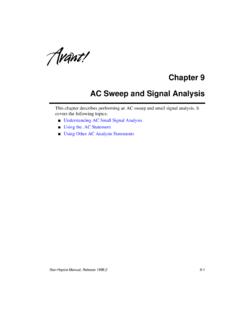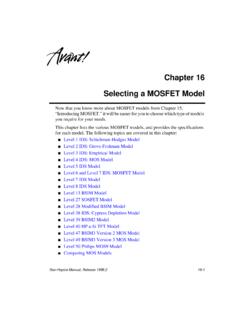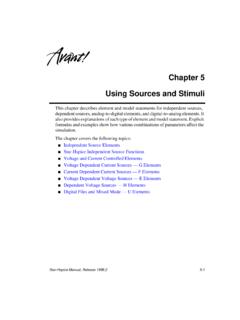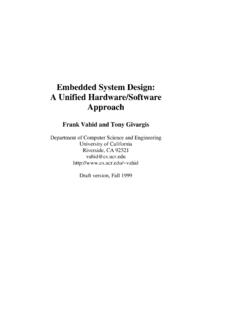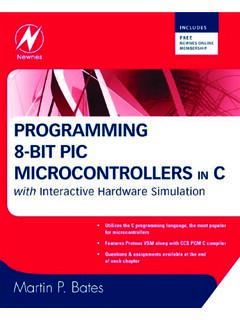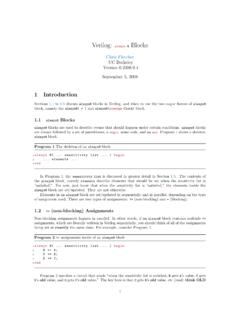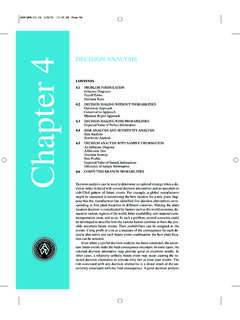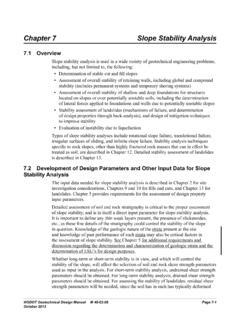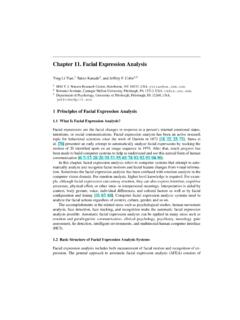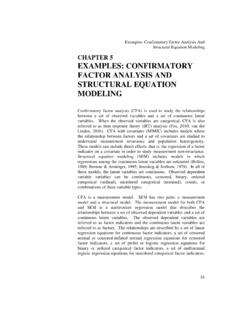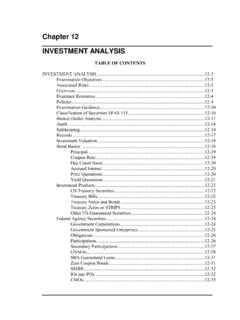Transcription of Chapter 7 Performing Transient Analysis - Class Home Pages
1 : 1 Thu Jul 23 19:10:43 1998 Star-Hspice Manual, Release 7 Performing Transient AnalysisStar-Hspice Transient Analysis computes the circuit solution as a function of timeover a time range specified in the .TRAN Chapter covers the following topics:nUnderstanding the Simulation FlownUnderstanding Transient AnalysisnUsing the .TRAN StatementnUnderstanding the Control OptionsnTesting for Speed, Accuracy and ConvergencenSelecting Timestep Control AlgorithmsnPerforming Fourier AnalysisnUsing Data Driven PWL : 2 Thu Jul 23 19:10:43 1998 Understanding the Simulation FlowPerforming Transient Analysis7-2 Star-Hspice Manual, Release the Simulation FlowFigure 7-1 illustrates the Transient Analysis simulation flow for 7-1.
2 Transient Analysis Simulation FlowBYPASSCSHUNTFASTLVLTIM=xMAXORD=xMETH ODABSV=xABSVAR=xACCURATEBYTOL=xCHGTOL=xD ELMAX=xMBYPASSMURELQ=xRELTOLRELV=xRELVAR =xSLOPETOL=xTRTOL=xVNTOLAUTOSTOPBKPSIZDV TR=xFS=xFT=xIMAX=xIMIN=xITL3=xITL4=xITL5 =xRMAX=xRMIN=xGMIN= ExperimentTime-sweepDC Op. : 3 Thu Jul 23 19:10:43 1998 Performing Transient AnalysisUnderstanding Transient AnalysisStar-Hspice Manual, Release Transient AnalysisSince Transient Analysis is dependent on time, it uses different analysisalgorithms, control options with different convergence-related issues anddifferent initialization parameters than DC Analysis .
3 However, since a transientanalysis first performs a DC operating point Analysis (unless the UIC option isspecified in the .TRAN statement), most of the DC Analysis algorithms, controloptions, and initialization and convergence issues apply to Transient Analysis . Initial Conditions for Transient AnalysisSome circuits, such as oscillators or circuits with feedback, do not have stableoperating point solutions. For these circuits, either the feedback loop must bebroken so that a DC operating point can be calculated or the initial conditionsmust be provided in the simulation input. The DC operating point Analysis isbypassed if the UIC parameter is included in the.
4 TRAN statement. If UIC isincluded in the .TRAN statement, a Transient Analysis is started using nodevoltages specified in an .IC statement. If a node is set to 5 V in a .IC statement,the value at that node for the first time point (time 0) is 5 can use the .OP statement to store an estimate of the DC operating pointduring a Transient 1ns 100ns 20nsThe .TRAN statement UIC parameter in the above example bypasses the initialDC operating point Analysis . The .OP statement calculates Transient operatingpoints at t=0 and t=20 ns during the Transient a Transient Analysis might provide a convergent DC solution, thetransient Analysis itself can still fail to converge.
5 In a Transient Analysis , the errormessage internal timestep too small indicates that the circuit failed toconverge. The convergence failure might be due to stated initial conditions thatare not close enough to the actual DC operating point : 4 Thu Jul 23 19:10:43 1998 Using the .TRAN StatementPerforming Transient Analysis7-4 Star-Hspice Manual, Release the .TRAN StatementSyntaxSingle-point Analysis :.TRAN var1 START=start1 STOP=stop1 STEP= var1 START=<param_expr1> STOP=<param_expr2>+ STEP=<param_expr3>Double-point Analysis :.TRAN var1 START=start1 STOP=stop1 STEP=incr1+ <SWEEP var2 type np start2 stop2> tincr1 tstop1 <tincr2 tstop2.
6 TincrN tstopN>+ <START=val> <UIC> + <SWEEP var pstart+ pstop pincr>Parameterized sweep:.TRAN tincr1 tstop1 <tincr2 tstop2 ..tincrN tstopN>+ <START=val> <UIC>Data driven sweep:.TRAN DATA= var1 START=start1 STOP=stop1 STEP=incr1+ <SWEEP DATA=datanm> DATA=datanm<SWEEP var pstart pstop pincr>Monte Carlo:.TRAN tincr1 tstop1 <tincr2 tstop2 ..tincrN tstopN>+ <START=val> <UIC> <SWEEP MONTE=val> : 5 Thu Jul 23 19:10:43 1998 Performing Transient AnalysisUsing the .TRAN StatementStar-Hspice Manual, Release :.TRAN DATA=datanm OPTIMIZE=opt_par_fun+ RESULTS=measnames MODEL=optmodTransient sweep specifications can include the following keywords andparameters:DATA=datanmdata name referred to in the.
7 TRAN statementMONTE=valproduces a numberval of randomly generated values that areused to select parameters from a distribution. Thedistribution can beGaussian,Uniform, orRandom of points or number of points per decade or octave,depending on the preceding expressions for example, , current, element or model parameter, or temperatureincrement valueNote:If type variation is used, the np (numberof points) is specified instead of pincr .pstartstarting voltage, current, temperature, any element or modelparameter valueNote:If type variation POI is used (list of points),a list of parameter values is specified instead of pstart pstop.
8 Pstopfinal voltage, current, temperature, any element or modelparameter valueSTART time at which printing or plotting is to begin. The START keyword is optional: you can specify start time withoutpreceding it with START= Note:If the .TRAN statement is used inconjunction with a .MEASURE statement, using anonzero START time can result in results. Nonzero START times : 6 Thu Jul 23 19:10:43 1998 Using the .TRAN StatementPerforming Transient Analysis7-6 Star-Hspice Manual, Release be used in .TRAN statements when .MEASURE also is being to indicate a second sweep is specified on or plotting increment for printer output, and thesuggested computing increment for the at which the Transient Analysis stops incrementing bytincr1.
9 If another tincr-tstop pair follows, the analysiscontinues with the new any of the following keywords:DEC decade variationOCT octave variation (the value of the designated variableis eight times its previous value)LIN linear variationPOI list of pointsUICcauses Star-Hspice to use the nodal voltages specified in statement (or by the IC= parameters in the variouselement statements) to calculate the initial transientconditions, rather than solving for the quiescent operatingpointvarname of an independent voltage or current source, anyelement or model parameter, or the keyword TEMP(indicating a temperature sweep).
10 Star-Hspice supportssource value sweep, referring to the source name (SPICE style). However, if a parameter sweep, a .DATA statement,and a temperature sweep are specified, a parameter namemust be chosen for the source value and subsequentlyreferred to in the .TRAN statement. The parameter namemust not start with V or : 7 Thu Jul 23 19:10:43 1998 Performing Transient AnalysisUsing the .TRAN StatementStar-Hspice Manual, Release following example performs and prints the Transient Analysis every 1 ns for100 1NS 100 NSThe following example performs the calculation every ns for the first 25 ns,and then every 1 ns until 40 ns; the printing and plotting begin at 10.

